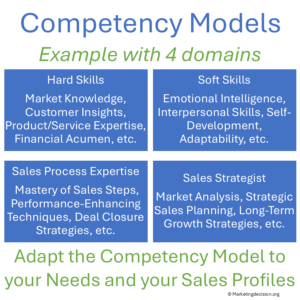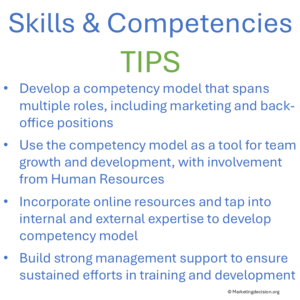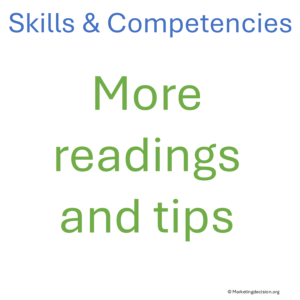Growing sales competencies is key to successful teams. This involves hard skills such as understanding products, features, capabilities, services offered, and key differentiators compared to the competition, as well as soft skills such as listening skills or demonstrating emotional intelligence.
 Becoming a successful salesperson is a journey, and the best salespersons have learned how to succeed through developing their own skills and capabilities, as well as by collaborating with others in their company. The traditional image of the “victorious” salesperson who alone wins deals with fierce determination and delivers consistently high-performance records is a legend. No salesperson ever wins a deal alone; training, support and advice are received from others. But what a successful salesperson does is build knowledge and expertise over time and leverage those skills and competencies and know when and how to seek support, when to challenge, and when to experiment. There is also not a single perfect “sales profile” where someone analytical or extroverted would be the best salesperson to hire. The best salespersons are probably the ones who understand their strengths and capabilities and continuously develop them.
Becoming a successful salesperson is a journey, and the best salespersons have learned how to succeed through developing their own skills and capabilities, as well as by collaborating with others in their company. The traditional image of the “victorious” salesperson who alone wins deals with fierce determination and delivers consistently high-performance records is a legend. No salesperson ever wins a deal alone; training, support and advice are received from others. But what a successful salesperson does is build knowledge and expertise over time and leverage those skills and competencies and know when and how to seek support, when to challenge, and when to experiment. There is also not a single perfect “sales profile” where someone analytical or extroverted would be the best salesperson to hire. The best salespersons are probably the ones who understand their strengths and capabilities and continuously develop them.
Making a distinction between skills and competencies:
 Skills seem inherent; they originate from a person’s childhood and heritage. They have been nurtured over years and tend to be well-mastered by the individual. Under pressure, these traits often resurface as a reference. Skills can be cultivated and developed; they can be utilized efficiently or put on hold when necessary. Mastering these skills is important.
Skills seem inherent; they originate from a person’s childhood and heritage. They have been nurtured over years and tend to be well-mastered by the individual. Under pressure, these traits often resurface as a reference. Skills can be cultivated and developed; they can be utilized efficiently or put on hold when necessary. Mastering these skills is important.
Competencies are developed. Mastering a Customer Relationship Management (CRM) system or understanding the benefits of solutions for various customer segments must be learned.
By comparison, behaviors are what people demonstrate when facing situations and exercising their skills and competencies. Behaviors are indeed different from those. One can develop skills and competencies, and one will demonstrate behaviors. Skills and competencies are essential for sales force effectiveness.
Enhancing the strengths of a sales organization is vital. It begins with sales meetings where experienced sales professionals share successful sales encounters against competitors and elaborate on sales tactics and strategies. This learning process extends to marketing and sales gatherings where product features and positioning are deliberated upon, and it further evolves through various sales training sessions covering topics such as sales techniques, legal aspects, finance, and more.
 There are numerous opportunities to meet with sales colleagues for training. Even informal discussions during sales meetings, where sales opportunities are collectively or group-wise explored, serve as valuable sales training, fostering strong commitment and enthusiasm towards sales strategies and tactics. Although these informal sessions are often among the most effective forms of sales training, they may not always be recognized as such. On the other hand, dedicated sales training sessions focusing on tools, finance, CRM capabilities, etc., are also key and should be conducted in an engaging and efficient manner.
There are numerous opportunities to meet with sales colleagues for training. Even informal discussions during sales meetings, where sales opportunities are collectively or group-wise explored, serve as valuable sales training, fostering strong commitment and enthusiasm towards sales strategies and tactics. Although these informal sessions are often among the most effective forms of sales training, they may not always be recognized as such. On the other hand, dedicated sales training sessions focusing on tools, finance, CRM capabilities, etc., are also key and should be conducted in an engaging and efficient manner.
“Learning from Mistakes is Expensive”
 Without adequate sales training, salespersons may resort to trial and error with sales tactics, potentially leading to missed opportunities. Identifying training needs early is crucial to increasing wins and improving profitability. While it can be challenging to assess the financial impact of training, analyzing past win and loss data may reveal instances where deals were lost due to factors such as insufficient product knowledge, ineffective messaging on product features, incorrect product positioning, inappropriate pricing strategies, failure to identify key decision-makers and influencers, etc. The cumulative impact of these lost deals likely represents a significant portion of total revenue and profitability, highlighting the importance of training.
Without adequate sales training, salespersons may resort to trial and error with sales tactics, potentially leading to missed opportunities. Identifying training needs early is crucial to increasing wins and improving profitability. While it can be challenging to assess the financial impact of training, analyzing past win and loss data may reveal instances where deals were lost due to factors such as insufficient product knowledge, ineffective messaging on product features, incorrect product positioning, inappropriate pricing strategies, failure to identify key decision-makers and influencers, etc. The cumulative impact of these lost deals likely represents a significant portion of total revenue and profitability, highlighting the importance of training.
This chapter begins with an emphasis on everyday training opportunities because salespersons learn best when they share sales practices among themselves. The most effective sales teams regularly meet to discuss business matters, share sales experiences, and learn from each other. It is common practice to start the week (or every two weeks, depending on your business) with a brief call to review business opportunities, discuss challenges, explore opportunities, analyze sales tactics, evaluate competitive actions, and take necessary steps.
 The best salespeople are not those who are merely average or proficient across all sales competencies. Instead, they are often individuals who excel in specific areas and know how to manage or compensate for areas where they may be less strong. These “strengths” frequently complement competencies that might sometimes be seen as lacking. For this reason, it is better to avoid labeling these areas as “weaknesses.” A more constructive term is “needs for development.” By addressing both strengths and “needs for development,” we can help individual grow all their competencies.
The best salespeople are not those who are merely average or proficient across all sales competencies. Instead, they are often individuals who excel in specific areas and know how to manage or compensate for areas where they may be less strong. These “strengths” frequently complement competencies that might sometimes be seen as lacking. For this reason, it is better to avoid labeling these areas as “weaknesses.” A more constructive term is “needs for development.” By addressing both strengths and “needs for development,” we can help individual grow all their competencies.
 Sales often operate with small teams consisting of a few salespersons. It’s crucial to ensure that these teams understand and utilize the strengths of each member and understand how to best leverage their collective capabilities. The most effective sales teams operate at the highest level of competency for each competency across the team.
Sales often operate with small teams consisting of a few salespersons. It’s crucial to ensure that these teams understand and utilize the strengths of each member and understand how to best leverage their collective capabilities. The most effective sales teams operate at the highest level of competency for each competency across the team.
Many competencies can be categorized into hard skills and soft skills. Hard skills relate to understanding products/solutions, the market, customers, competition, sales tools, and various other concrete topics, whereas soft skills include sales approach, teamwork, collaboration, and other skills crucial for understanding customer needs, closing deals, and delivering results. However, two categories are not sufficient.
 A useful aspect of sales training is its role as a management tool. It offers valuable opportunities for managers and employees to discuss competencies and areas for development. Managers can assist individuals in growing their competencies with the support of HR and relevant departments. Providing objective and structured feedback to employees is crucial. Ideally, these steps should be implemented sequentially:
A useful aspect of sales training is its role as a management tool. It offers valuable opportunities for managers and employees to discuss competencies and areas for development. Managers can assist individuals in growing their competencies with the support of HR and relevant departments. Providing objective and structured feedback to employees is crucial. Ideally, these steps should be implemented sequentially:
The core capability is delivered through a sales competency model, where appropriate training is recommended for each development need, considering the individual’s role, current level of expertise, and growth objectives.
For each step, here are some recommendations:
 Assessing sales competencies: As a manager, take time to consolidate your assessment for each salesperson working with you and possibly others who are recommended to you (e.g., for mentorship). Ensure to include examples of desired behaviors. Be concrete and prepare to share in a positive manner. Consider both strengths and needs for development.
Assessing sales competencies: As a manager, take time to consolidate your assessment for each salesperson working with you and possibly others who are recommended to you (e.g., for mentorship). Ensure to include examples of desired behaviors. Be concrete and prepare to share in a positive manner. Consider both strengths and needs for development.
Sharing strengths and areas for development: In a meeting with your colleague, deliver a fair and unbiased assessment as part of a conversation. Leverage existing practices and share examples of practices you consider more appropriate. It’s not necessary for the person to approve your examples, but it’s necessary to share your perception and why you hold this perception for better understanding. There is no issue with a need for development; it has been demonstrated that the best salespersons are not those who are proficient in every segment of a sales competency model. They are those who excel in some segments and know how to address areas where skills – sometimes even more than competencies – are playing against themselves. For that reason, strengths must also be developed. Best managers nurture strengths as well as focus on needs for development in individuals.

Providing training recommendations: During the same meeting or in a follow-up meeting, share the recommended approach, whether formal training, coaching, or another method. Ensure it is practical and that the salesperson agrees with the training path.
Following up on training delivery: Follow up on training delivery and provide feedback through one-to-one discussions.
Training should be provided gradually, and when multiple needs for development are identified, prioritize training sessions. Address hard skills promptly when essential for conducting sales activities, while addressing soft skills through appropriate actions.
Consider mentoring as a solution. It can be as simple as pairing and connecting sales individuals, one with a recognized strength and one needing development in this capacity. Let them share and discuss informally between themselves. Gather their feedback after a while.
Developing a sales competency model is a collaborative effort involving Human Resources, a sales training team and stakeholders from sales and marketing functions including CRM experts.
 What are the multiple dimensions of skills and competencies expected from the various roles in sales and support functions? What behaviors are anticipated from individuals interacting with customers? A sales competency model will include many of these dimensions with differing expectations for each sales and support role:
What are the multiple dimensions of skills and competencies expected from the various roles in sales and support functions? What behaviors are anticipated from individuals interacting with customers? A sales competency model will include many of these dimensions with differing expectations for each sales and support role:
Market, Customers, product/solution offerings, Financial offerings, Service/Maintenance…
These competencies are considered hard skills. No deal can be won without continuously developing a deep understanding of products/solutions and the competitive landscape, as well as mastering sales tactics.
Team player/Strong Emotional Intelligence
Numerous skills are associated with being a good team member and effectively leveraging and developing strengths and competencies within the team. This category may include various competencies, with some being more important for employees and others more crucial for managers.
Sales process expertise
Understanding the various steps and approaches to maximize sales, from discovering customer needs to delivering outcomes, is essential. Companies often develop various methodologies, typically integrated into Customer Relationship Management (CRM) systems. Each step can be elaborated upon for appropriate training solutions, such as discovering customer needs or developing influencing models.
Strategic competencies
Many competencies pertain to the ability to analyze the market, organize sales teams, and consolidate expertise to formulate long-term plans. These skills differ from tactical competencies, which are usually focused on individual deals, and take into account the market as a whole.
 All sales and management roles include these skills and competencies. When considering marketing, additional skills aligned with the marketing mix model need to be taken into account.
All sales and management roles include these skills and competencies. When considering marketing, additional skills aligned with the marketing mix model need to be taken into account.
When developing a competency model, consider the following criteria for effectiveness:
Such competency models typically target sales and support functions. Once developed for this primary target, consider including marketing roles and other positions requiring customer-facing, market understanding, sales strategy, and tactics competencies and skills.
 There are numerous resources available on sales competency models. Here is a brief selection:
There are numerous resources available on sales competency models. Here is a brief selection:
The Canadian Sales Association was proposing until the end of 2024 a sales competency model covering various sales roles.
This information can be searched for on the internet. See also their learning hub: https://www.cpsa.com/learning-hub
Developing sales competencies is key to successful teams. It’s essential to discuss competency assessments with sales teams and ensure actions are taken to facilitate training. Training that engages sales individuals and mirrors real-life situations they encounter is the most effective.
Ensure that all levels of your organization value sales training and demonstrate this commitment. Your customers will perceive this transformation and appreciate the high-caliber individuals representing your company.
© marketingdecision.org
There are numerous tools available on the market for assessing sales competencies. Choose tools that allow fair and constructive discussions between managers and employees, and that facilitate “on-the-job” training for sales staff. For example, nothing is more effective than working on real-life situations with support from a more experienced colleague. Coaching and mentoring are key.
Leverage scorecards to compare solutions, but only when performance criteria—your “success factors”—are fully agreed upon by the team.
The following section may include tools, some free, some with a fee to support this site development. If you consider a tool should be presented in this section and is missing, please let us know at: contact@marketingdecision.org
© 2025 MARKETING DECISION SOLUTIONS. All Rights Reserved.